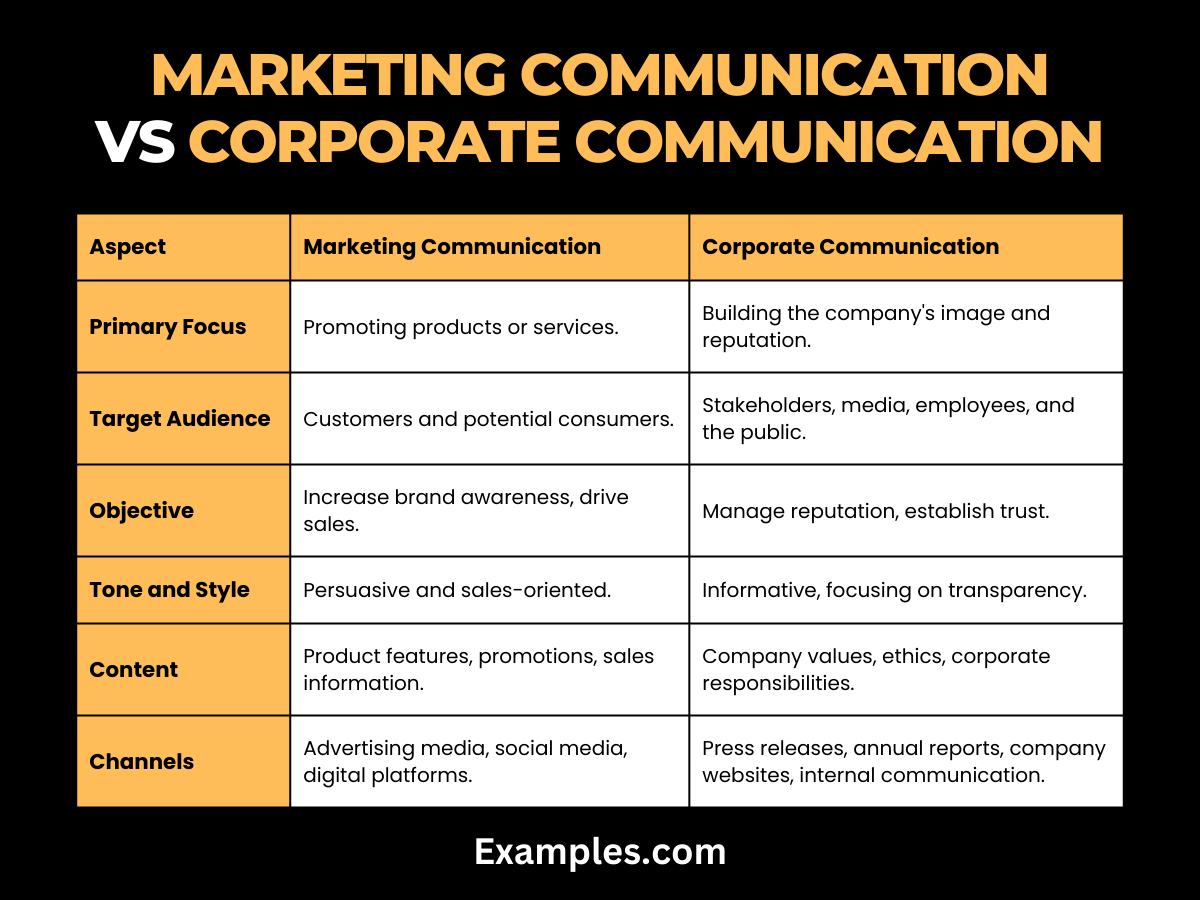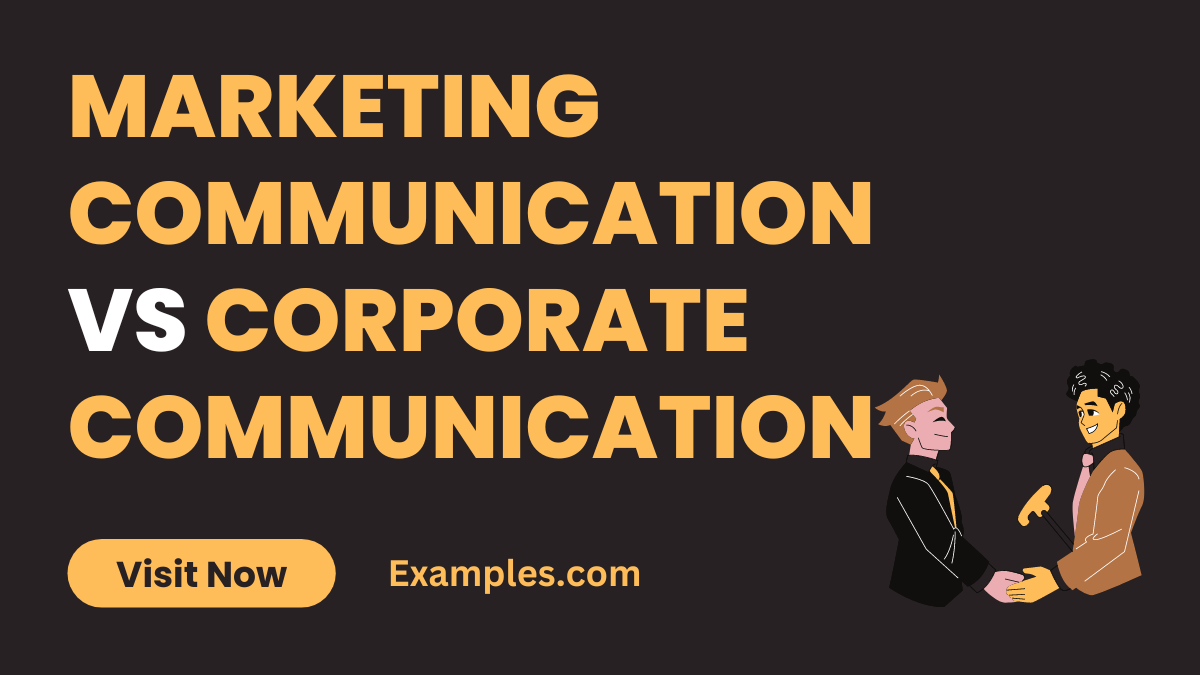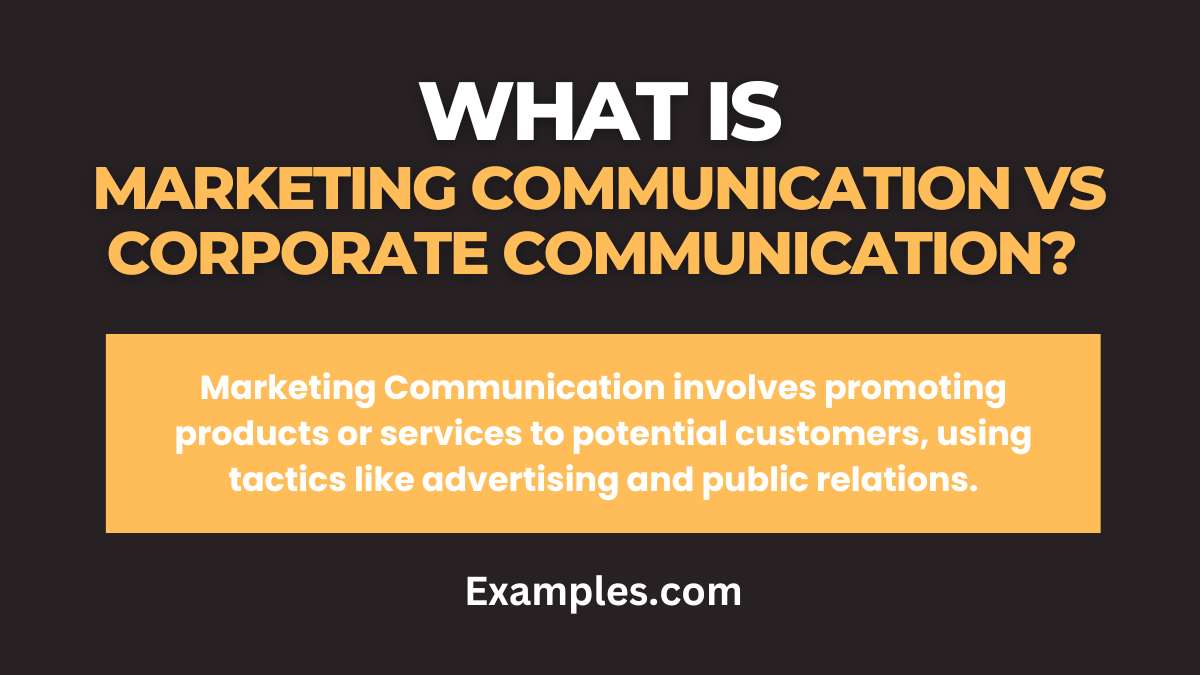Marketing Communication vs Corporate Communication – 19+ Examples
Discover the distinct worlds of Marketing Communication and Corporate Communication with this insightful guide. Packed with Marketing Communication Examples and detailed comparisons, it delineates the unique functions, approaches, and impacts of each communication type within a business context. Whether you’re a marketing novice or a seasoned corporate communicator, this guide provides practical insights and sentence examples to effectively navigate and leverage both fields for business success.
What is Marketing Communication vs Corporate Communication?
Marketing Communication involves promoting products or services to potential customers, using tactics like advertising and public relations. Corporate Communication, on the other hand, is broader and includes managing internal and external communication for a company, focusing on maintaining a positive corporate image and facilitating effective information flow within the organization.
Difference between Marketing Communication vs Corporate Communication
Understanding the distinct roles and functions of Marketing Communication and Corporate Communication is crucial in the business world. Here’s a table that outlines the key differences between these two types of communication:

| Aspect | Marketing Communication | Corporate Communication |
|---|---|---|
| Primary Focus | Primarily focused on promoting and selling products or services. | Focused on building and maintaining the company’s image and reputation. |
| Target Audience | Targeted towards customers and potential consumers. | Targets a broader audience including employees, stakeholders, media, and the general public. |
| Objective | Aims to drive sales, increase brand awareness, and encourage product or service adoption. | Aims to establish and maintain positive relationships with stakeholders and manage the company’s reputation. |
| Tone and Style | Often persuasive and sales-oriented. | Generally informative, aiming to build trust and transparency. |
| Content Focus | Product features, benefits, promotions, and sales information. | Company values, ethics, achievements, and corporate responsibilities. |
| Channels Used | Utilizes advertising channels like TV, radio, digital media, print, and social media. | Involves corporate channels like press releases, annual reports, company websites, and internal communications. |
| Frequency of Communication | Often campaign-based and aligned with marketing strategies and goals. | Regular and ongoing to ensure consistent engagement with stakeholders. |
| Measurability | Focuses on metrics like ROI, conversion rates, and customer engagement. | Measured through reputation analysis, employee engagement levels, and media presence. |
| Strategic Role | Directly linked to sales and marketing goals of the business. | Linked to the overall corporate strategy and brand positioning. |
| Feedback Mechanism | Consumer feedback is frequently sought for product improvement and market understanding. | Stakeholder feedback is gathered to improve corporate practices and policies. |
10 Examples of Marketing Communication
Marketing Communication plays a vital role in connecting businesses with their target audience. Here are ten diverse examples that highlight the scope of marketing communication:
- Social Media Campaigns: Utilizing platforms like Facebook and Instagram to engage with consumers and promote products or services.
- Email Newsletters: Regularly sending curated content, updates, or promotional offers to a list of subscribers.
- Television Commercials: Creating visual and auditory content for TV to reach a broad audience with brand messaging.
- Print Advertising: Placing ads in newspapers, magazines, or brochures to target specific demographics or interests.
- Online Banner Ads: Using web banners on various websites to drive traffic and increase product awareness.
- Radio Spots: Broadcasting audio advertisements on radio stations to reach local or national audiences.
- Direct Mail: Sending physical marketing materials like postcards, catalogs, or flyers directly to consumers’ homes.
- Trade Shows and Exhibitions: Participating in industry events to showcase products or services and engage with potential clients.
- Content Marketing: Creating and sharing valuable content like blogs, videos, or infographics to attract and retain a target audience.
- Influencer Collaborations: Partnering with social media influencers to promote products or services to their followers.
10 Examples of Corporate Communication
Corporate Communication encompasses a range of strategies and tools aimed at effectively conveying a company’s internal and external messaging. Here are ten examples that illustrate the breadth of corporate communication:
- Annual Reports: Publishing detailed reports on the company’s yearly performance, financial status, and future outlook.
- Internal Newsletters: Distributing regular newsletters to employees about company news, updates, and internal initiatives.
- Press Releases: Official statements issued to the media to announce new developments, products, or company achievements.
- Corporate Websites: Maintaining a website with comprehensive information about the company, its mission, and values.
- Crisis Communication Plans: Implementing strategies to address and manage communications during a crisis or emergency.
- Employee Town Halls: Organizing regular meetings where executives communicate with and receive feedback from employees.
- Sustainability Reports: Reports showcasing the company’s efforts and commitment to sustainable practices.
- Investor Relations Communications: Communications specifically tailored for shareholders and investors, including quarterly earnings calls and investor meetings.
- Corporate Social Responsibility (CSR) Programs: Communicating the company’s initiatives in giving back to the community or engaging in social causes.
- Corporate Branding Materials: Developing and distributing materials that consistently represent the company’s brand identity across various touchpoints.
Comparison Between Marketing Communication vs Corporate Communication
Understanding the differences between Marketing Communication and Corporate Communication is crucial for any business or communication professional. While both are integral to a company’s success, they serve distinct purposes and utilize different strategies and channels. This comprehensive guide explores the key differences between these two vital communication forms.
- Objective and Focus: Marketing Communication primarily focuses on promoting and selling products or services, using techniques like advertising, sales promotions, and Social Media Marketing Communication. In contrast, Corporate Communication encompasses a broader spectrum, handling internal and external communication and focusing on building and maintaining the company’s reputation.
- Target Audience: The target audience for Marketing Communication is mainly potential and existing customers. Corporate Communication, however, addresses a wider audience, including employees, stakeholders, media, and the general public.
- Tone and Content: Marketing Communication often employs persuasive and sales-driven language, showcasing Marketing Communication Examples and campaigns. Corporate Communication tends to be more informational and formal, aiming to present a consistent corporate image.
- Channels Used: Marketing Communication Channels include digital platforms, television, radio, and print media for advertisements and promotional content. Corporate Communication uses press releases, corporate reports, internal newsletters, and public statements.
- Measurement of Success: The success of Marketing Communication is typically measured by sales figures and campaign engagement rates. Corporate Communication success is gauged by reputation management, effective crisis handling, and stakeholder relations.
Relationship Between Marketing Communication and Corporate Communication
While Marketing Communication and Corporate Communication serve different purposes, their relationship is symbiotic and crucial for the overall communication strategy of a business. This section explores how these two communication forms interlink and support each other.
- Complementary Goals: While Marketing Communication aims to drive sales and brand awareness, Corporate Communication seeks to build trust and a positive image. Both contribute to the overarching goal of business growth and sustainability.
- Consistent Messaging: Effective Marketing Communication Strategies must align with the broader corporate message. This consistency ensures that marketing campaigns resonate with the company’s core values and corporate identity.
- Supportive Roles: Strong corporate communication can enhance the effectiveness of marketing communication. For instance, a well-maintained corporate reputation can make marketing campaigns more credible and impactful.
- Integrated Approach: Many companies are adopting an integrated approach, where marketing and corporate communication strategies are closely aligned. This helps in delivering a unified message across all platforms, enhancing brand coherence.
- Collaboration in Crisis Management: In times of crisis, Marketing Communication and Corporate Communication teams must work together. Marketing can adjust campaigns to suit the situation, while corporate communication handles public relations and internal communication.




